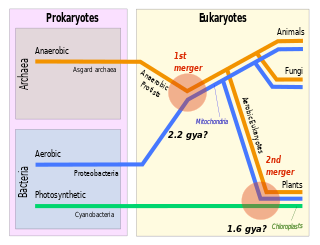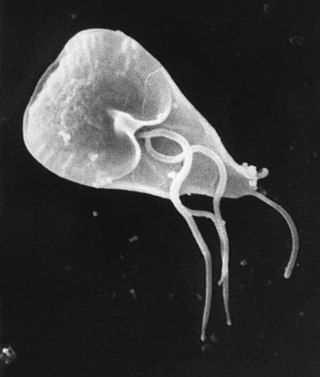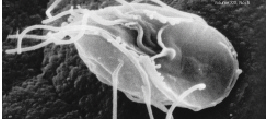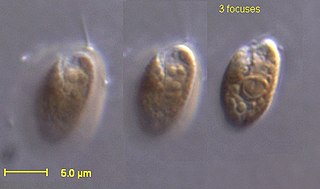Related Research Articles

Entamoeba is a genus of Amoebozoa found as internal parasites or commensals of animals. In 1875, Fedor Lösch described the first proven case of amoebic dysentery in St. Petersburg, Russia. He referred to the amoeba he observed microscopically as Amoeba coli; however, it is not clear whether he was using this as a descriptive term or intended it as a formal taxonomic name. The genus Entamoeba was defined by Casagrandi and Barbagallo for the species Entamoeba coli, which is known to be a commensal organism. Lösch's organism was renamed Entamoeba histolytica by Fritz Schaudinn in 1903; he later died, in 1906, from a self-inflicted infection when studying this amoeba. For a time during the first half of the 20th century the entire genus Entamoeba was transferred to Endamoeba, a genus of amoebas infecting invertebrates about which little is known. This move was reversed by the International Commission on Zoological Nomenclature in the late 1950s, and Entamoeba has stayed 'stable' ever since.

A mitochondrion is an organelle found in the cells of most eukaryotes, such as animals, plants and fungi. Mitochondria have a double membrane structure and use aerobic respiration to generate adenosine triphosphate (ATP), which is used throughout the cell as a source of chemical energy. They were discovered by Albert von Kölliker in 1857 in the voluntary muscles of insects. The term mitochondrion was coined by Carl Benda in 1898. The mitochondrion is popularly nicknamed the "powerhouse of the cell", a phrase coined by Philip Siekevitz in a 1957 article of the same name.

Symbiogenesis is the leading evolutionary theory of the origin of eukaryotic cells from prokaryotic organisms. The theory holds that mitochondria, plastids such as chloroplasts, and possibly other organelles of eukaryotic cells are descended from formerly free-living prokaryotes taken one inside the other in endosymbiosis. Mitochondria appear to be phylogenetically related to Rickettsiales bacteria, while chloroplasts are thought to be related to cyanobacteria.

Giardia is a genus of anaerobic flagellated protozoan parasites of the phylum Metamonada that colonise and reproduce in the small intestines of several vertebrates, causing the disease giardiasis. Their life cycle alternates between a swimming trophozoite and an infective, resistant cyst. Giardia were first described by the Dutch microscopist Antonie van Leeuwenhoek in 1681. The genus is named after French zoologist Alfred Mathieu Giard.

Excavata is an extensive and diverse but paraphyletic group of unicellular Eukaryota. The group was first suggested by Simpson and Patterson in 1999 and the name latinized and assigned a rank by Thomas Cavalier-Smith in 2002. It contains a variety of free-living and symbiotic protists, and includes some important parasites of humans such as Giardia and Trichomonas. Excavates were formerly considered to be included in the now obsolete Protista kingdom. They were distinguished from other lineages based on electron-microscopic information about how the cells are arranged. They are considered to be a basal flagellate lineage.

Giardia duodenalis, also known as Giardia intestinalis and Giardia lamblia, is a flagellated parasitic protozoan microorganism of the genus Giardia that colonizes the small intestine, causing a diarrheal condition known as giardiasis. The parasite attaches to the intestinal epithelium by a adhesive disc or sucker, and reproduces via binary fission. Giardiasis does not spread to other parts of the gastrointestinal tract, but remains confined to the lumen of the small intestine. The microorganism has an outer membrane that makes it possible to survive even when outside of its host, and which can render it tolerant to certain disinfectants. Giardia trophozoites are anaerobic, and absorb their nutrients from the intestinal lumen. If the organism is stained, its characteristic pattern resembles the familiar "smiley face" symbol.

The diplomonads are a group of flagellates, most of which are parasitic. They include Giardia duodenalis, which causes giardiasis in humans. They are placed among the metamonads, and appear to be particularly close relatives of the retortamonads.
In Biology, Archezoa is a term that has been introduced by several authors to refer to a group of organisms. Authors include Josef Anton Maximilian Perty, Ernst Haeckel and in the 20th century by Thomas Cavalier-Smith (1942–2021) in his classification system. Each author used the name to refer to different arrays of organisms. This reuse by later authors of the same taxon name for different groups of organisms is widely criticized in taxonomy because the inclusion of the name in a sentence does not make sense unless the particular usage is specified. All uses of 'Archezoa' are now obsolete.

A hydrogenosome is a membrane-enclosed organelle found in some anaerobic ciliates, flagellates, and fungi. Hydrogenosomes are highly variable organelles that have presumably evolved from protomitochondria to produce molecular hydrogen and ATP in anaerobic conditions.

Henneguya zschokkei or Henneguya salminicola is a species of a myxosporean endoparasite. It afflicts several salmon in the genus Oncorhynchus. It causes milky flesh or tapioca disease. H. zschokkei is notable for its lack of mitochondria, mitochondrial DNA, aerobic respiration and its reliance on an exclusively anaerobic metabolism.
Spironucleus salmonicida is a species of fish parasite. It is a flagellate adapted to micro-aerobic environments that causes systemic infections in salmonid fish. The species creates foul-smelling, pus-filled abscesses in muscles and internal organs of aquarium fish. In the late 1980s when the disease was first reported, it was believed to be caused by Spironucleus barkhanus. Anders Jørgensen was the person that found out what species really caused the disease.

Breviata anathema is a single-celled flagellate amoeboid eukaryote, previously studied under the name Mastigamoeba invertens. The cell lacks mitochondria, but has remnant mitochondrial genes, and possesses an organelle believed to be a modified anaerobic mitochondrion, similar to the mitosomes and hydrogenosomes found in other eukaryotes that live in low-oxygen environments.
Trimastix is a genus of excavates, the sole occupant of the order Trimastigida. Trimastix are bacterivorous, free living and anaerobic. When first observed in 1881 by William Kent, the morphology of Trimastix was not well described but over time the oral structure and flagellar organization have become clearer. There are few known species, and the genus's role in the ecosystem is largely unknown. However, it is known that they generally live in marine environments within the tissues of decaying organisms to maintain an anoxic environment. Much interest in this group is related to its close association with other members of Anaeromonadea. These organisms do not have classical mitochondria, and as such, much of the research involving these microbes is aimed at investigating the evolution of mitochondria.

Mastigamoeba is a genus of pelobionts, and treated by some as members of the Archamoebae group of protists. Mastigamoeba are characterized as anaerobic, amitochondriate organisms that are polymorphic. Their dominant life cycle stage is as an amoeboid flagellate. Species are typically free living, though endobiotic species have been described.

The eukaryotes constitute the domain of Eukarya, organisms whose cells have a membrane-bound nucleus. All animals, plants, fungi, and many unicellular organisms are eukaryotes. They constitute a major group of life forms alongside the two groups of prokaryotes: the Bacteria and the Archaea. Eukaryotes represent a small minority of the number of organisms, but due to their generally much larger size, their collective global biomass is much larger than that of prokaryotes.

Breviatea, commonly known as breviate amoebae, are a group of free-living, amitochondriate protists with uncertain phylogenetic position. They are biflagellate, and can live in anaerobic (oxygen-free) environments. They are currently placed in the Obazoa clade. They likely do not possess vinculin proteins. Their metabolism relies on fermentative production of ATP as an adaptation to their low-oxygen environment.
Monocercomonoides is a genus of flagellate Excavata belonging to the order Oxymonadida. It was established by Bernard V. Travis and was first described as those with "polymastiginid flagellates having three anterior flagella and a trailing one originating at a single basal granule located in front of the anteriorly positioned nucleus, and a more or less well-defined axostyle". It is the first eukaryotic genus to be found to completely lack mitochondria, and all hallmark proteins responsible for mitochondrial function. The genus also lacks any other mitochondria related organelles (MROs) such as hydrogenosomes or mitosomes. Data suggests that the absence of mitochondria is not an ancestral feature, but rather due to secondary loss. Monocercomonoides sp. was found to obtain energy through an enzymatic action of nutrients absorbed from the environment. The genus has replaced the iron-sulfur cluster assembly pathway with a cytosolic sulfur mobilization system, likely acquired by horizontal gene transfer from a eubacterium of a common ancestor of oxymonads. These organisms are significant because they undermine assumptions that eukaryotes must have mitochondria to properly function. The genome of Monocercomonoides exilis has approximately 82 million base pairs, with 18 152 predicted protein-coding genes.

Andrew J. Roger is a Canadian-Australian molecular biologist and evolutionary bioinformatician. He is currently a professor in the Department of Biochemistry and Molecular Biology at Dalhousie University and was the founding director of the inter-departmental Centre for Comparative Genomics and Evolutionary Bioinformatics (CGEB).

Mark van der Giezen is Professor of Biological Chemistry, Centre for Organelle Research, University of Stavanger, Norway. He holds Dutch nationality and is married with three children.

Stygiellidae is a family of free-living marine flagellates belonging to the order Jakobida, a deep-branching lineage within the eukaryotic supergroup Discoba. They are unicellular organisms that commonly inhabit anoxic, sulfide-rich and ammonium-rich marine habitats worldwide.
References
- ↑ Mai Z, Ghosh S, Frisardi M, Rosenthal B, Rogers R, Samuelson J (March 1999). "Hsp60 is targeted to a cryptic mitochondrion-derived organelle ("crypton") in the microaerophilic protozoan parasite Entamoeba histolytica". Molecular and Cellular Biology. 19 (3): 2198–2205. doi:10.1128/MCB.19.3.2198. PMC 84012 . PMID 10022906.
- 1 2 3 4 5 6 7 8 9 Onuț-Brännström I, Stairs CW, Campos KI, Thorén MH, Ettema TJ, Keeling PJ, et al. (March 2023). Eme L (ed.). "A Mitosome With Distinct Metabolism in the Uncultured Protist Parasite Paramikrocytos canceri (Rhizaria, Ascetosporea)". Genome Biology and Evolution. 15 (3). doi:10.1093/gbe/evad022. PMC 9998036 . PMID 36790104.
- 1 2 3 4 5 6 7 Tovar J, Fischer A, Clark CG (June 1999). "The mitosome, a novel organelle related to mitochondria in the amitochondrial parasite Entamoeba histolytica". Molecular Microbiology. 32 (5): 1013–1021. doi: 10.1046/j.1365-2958.1999.01414.x . PMID 10361303.
- 1 2 3 Bakatselou C, Beste D, Kadri AO, Somanath S, Clark CG (2003). "Analysis of genes of mitochondrial origin in the genus Entamoeba". The Journal of Eukaryotic Microbiology. 50 (3): 210–214. doi:10.1111/j.1550-7408.2003.tb00119.x. PMID 12836878. S2CID 85169619.
- 1 2 3 Williams BA, Hirt RP, Lucocq JM, Embley TM (August 2002). "A mitochondrial remnant in the microsporidian Trachipleistophora hominis". Nature. 418 (6900): 865–869. Bibcode:2002Natur.418..865W. doi:10.1038/nature00949. PMID 12192407. S2CID 4358253.
- 1 2 3 4 5 Goldberg AV, Molik S, Tsaousis AD, Neumann K, Kuhnke G, Delbac F, et al. (April 2008). "Localization and functionality of microsporidian iron-sulphur cluster assembly proteins". Nature. 452 (7187): 624–628. Bibcode:2008Natur.452..624G. doi:10.1038/nature06606. PMID 18311129. S2CID 4431368.
- ↑ Tovar J, León-Avila G, Sánchez LB, Sutak R, Tachezy J, van der Giezen M, et al. (November 2003). "Mitochondrial remnant organelles of Giardia function in iron-sulphur protein maturation". Nature. 426 (6963): 172–176. Bibcode:2003Natur.426..172T. doi:10.1038/nature01945. PMID 14614504. S2CID 4402808.
- 1 2 3 Mi-ichi F, Abu Yousuf M, Nakada-Tsukui K, Nozaki T (December 2009). "Mitosomes in Entamoeba histolytica contain a sulfate activation pathway". Proceedings of the National Academy of Sciences of the United States of America. 106 (51): 21731–21736. Bibcode:2009PNAS..10621731M. doi: 10.1073/pnas.0907106106 . PMC 2799805 . PMID 19995967.
- 1 2 3 4 5 6 Santos HJ, Makiuchi T, Nozaki T (December 2018). "Reinventing an Organelle: The Reduced Mitochondrion in Parasitic Protists". Trends in Parasitology. 34 (12): 1038–1055. doi: 10.1016/j.pt.2018.08.008 . PMID 30201278. S2CID 52183593.
- 1 2 3 Dolezal P, Makki A, Dyall SD (2019). "Protein Import into Hydrogenosomes and Mitosomes". In Tachezy J (ed.). Hydrogenosomes and Mitosomes: Mitochondria of Anaerobic Eukaryotes. Microbiology Monographs. Vol. 9. Cham: Springer International Publishing. pp. 31–84. doi:10.1007/978-3-030-17941-0_3. ISBN 978-3-030-17941-0.
- ↑ Ghosh S, Field J, Rogers R, Hickman M, Samuelson J (July 2000). "The Entamoeba histolytica mitochondrion-derived organelle (crypton) contains double-stranded DNA and appears to be bound by a double membrane". Infection and Immunity. 68 (7): 4319–4322. doi:10.1128/IAI.68.7.4319-4322.2000. PMC 101756 . PMID 10858251.
- ↑ León-Avila G, Tovar J (May 2004). "Mitosomes of Entamoeba histolytica are abundant mitochondrion-related remnant organelles that lack a detectable organellar genome". Microbiology. 150 (Pt 5): 1245–1250. doi: 10.1099/mic.0.26923-0 . PMID 15133087.
- ↑ Martincová E, Voleman L, Pyrih J, Žárský V, Vondráčková P, Kolísko M, et al. (August 2015). "Probing the Biology of Giardia intestinalis Mitosomes Using In Vivo Enzymatic Tagging". Molecular and Cellular Biology. 35 (16): 2864–2874. doi:10.1128/MCB.00448-15. PMC 4508323 . PMID 26055323.
- 1 2 Mi-ichi F, Miyamoto T, Takao S, Jeelani G, Hashimoto T, Hara H, et al. (June 2015). "Entamoeba mitosomes play an important role in encystation by association with cholesteryl sulfate synthesis". Proceedings of the National Academy of Sciences of the United States of America. 112 (22): E2884–E2890. Bibcode:2015PNAS..112E2884M. doi: 10.1073/pnas.1423718112 . PMC 4460517 . PMID 25986376.
- ↑ Dolezal P, Smíd O, Rada P, Zubácová Z, Bursać D, Suták R, et al. (August 2005). "Giardia mitosomes and trichomonad hydrogenosomes share a common mode of protein targeting". Proceedings of the National Academy of Sciences of the United States of America. 102 (31): 10924–10929. Bibcode:2005PNAS..10210924D. doi: 10.1073/pnas.0500349102 . PMC 1182405 . PMID 16040811.
- ↑ Zimorski V, Martin WF (2019). "The Evolution of Oxygen-Independent Energy Metabolism in Eukaryotes with Hydrogenosomes and Mitosomes". In Tachezy J (ed.). Hydrogenosomes and Mitosomes: Mitochondria of Anaerobic Eukaryotes. Microbiology Monographs. Vol. 9. Cham: Springer International Publishing. pp. 7–29. doi:10.1007/978-3-030-17941-0_2. ISBN 978-3-030-17940-3. S2CID 202026532.